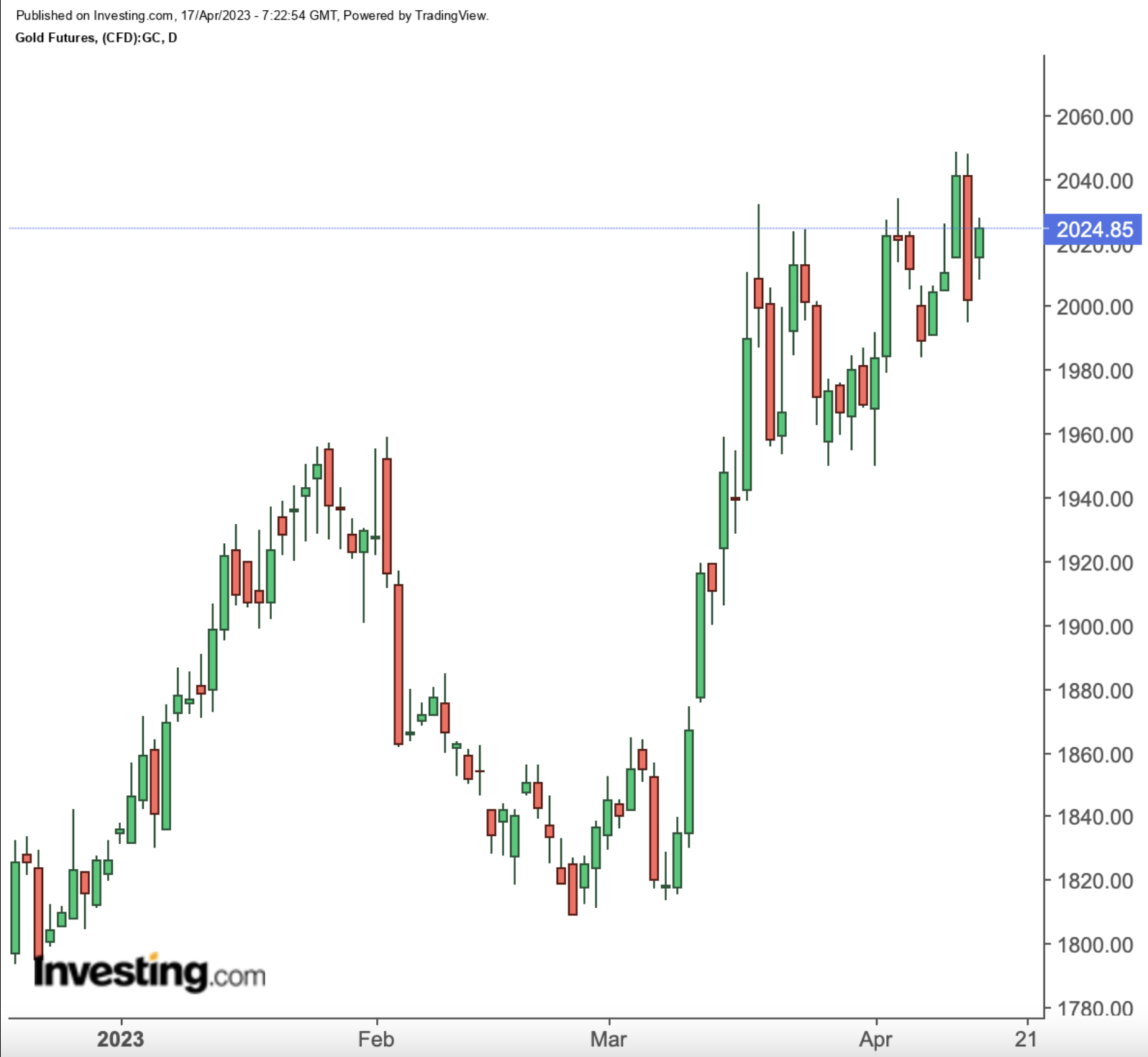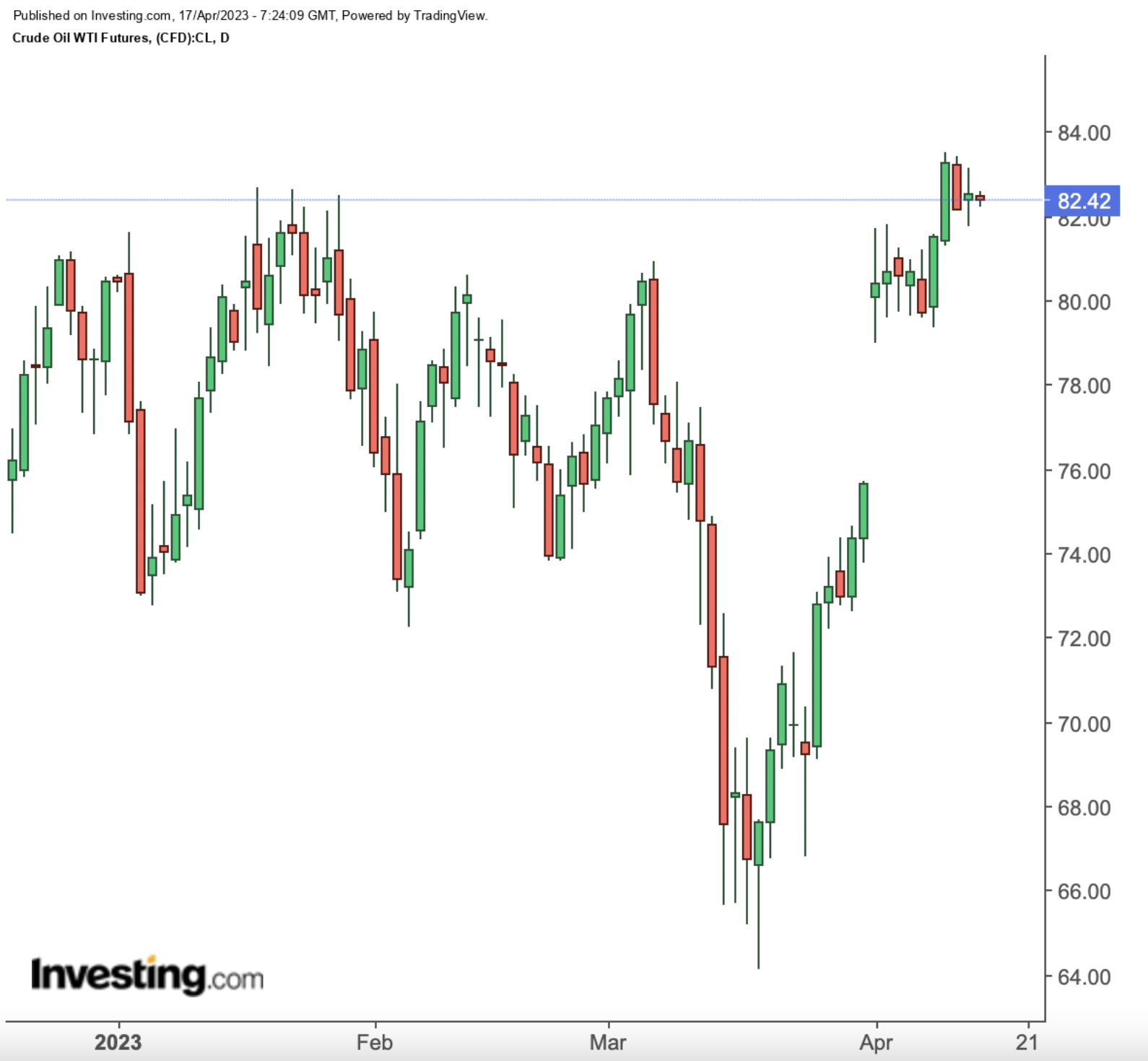- With 17 days to May 3 rate decision, Fed looks quite sure to add quarter point
- More tightening doesn’t really surprise but Fed acknowledged recession possibility
- Recent U.S. inflation data soft but March jobs report still unnerved Fed
- Gold gains some of Friday’s lost ground, oil directionless in early trade
It’s April 17 and there are 17 days to the Federal Reserve’s next rate decision. And oil and gold bulls are in no better position than they were when the month began amid a tinge of expectation that the central bank will be ready to hike rates again at its May 3rd decision.
More tightening wouldn’t be surprising on the Fed’s part, if not for data on easing inflation, which has been landing over the past two weeks.
Most investors are betting that the Fed will add another 25 basis points to rates despite the central bank acknowledging at its March policy meeting the increased risk of recession after recent turmoil in the U.S. banking sector.
In the next few days, investors will have a final chance to hear from Fed officials before they enter their traditional blackout period ahead of the meeting, including New York Fed President John Williams, Governor Michelle Bowman, Governor Lisa Cook and Governor Christopher Waller.
Waller, one of the Fed’s biggest policy hawks, raised the ante on higher rates when he made no secret last week of his desire for further monetary tightening.
Waller’s call helped trigger a mini-crash in prices of gold, which until Thursday had seemed to be on track to a new record peak. Higher interest rates tend to benefit the dollar and weigh on gold. While the yellow metal is a popular insurance against economic and political troubles, it does not yield anything.
Gold futures regained some ground in Monday’s Asian trade, climbing almost $10 to a session high of $2,025 after settling down nearly $40, or 2%, on Friday for its largest one-day decline in three weeks.

Gold wasn’t the only commodity that took a hit from Waller’s remarks on Friday. The dollar’s rebound from a one-year low also led crude to settle with just a modest advance instead of what might have been larger gains, after global energy agency IEA upgraded oil's demand prospects in 2023.
Crude prices were a touch higher in Monday’s preliminary trade for both the U.S. West Texas Intermediate, or WTI, and London-traded Brent. The oil benchmarks gained less than half a percent on Friday, although for last week itself they advanced more than 1% each.

On oil’s part, top importer China is to release a flurry of economic data on Tuesday, including reports on first quarter gross domestic product, March retail sales and industrial production, with market participants hoping for more clarity on the uneven recovery in the world’s second-largest economy.
While Chinese exports are increasing and credit growth is solid, inflation remains subdued as the consumer and industrial sectors struggle to recover in the wake of the hit from harsh pandemic-era restrictions.
Policymakers have pledged to step up support for the economy, which recorded one of its worst performances in nearly half a century last year due to the strict COVID-19 curbs.
The U.S. dollar, meanwhile, extended its rebound on Monday from last week’s one-year low, limiting gains in some commodities and pressuring others lower.

The U.S. earnings season also gets underway in earnest this week, with early signs of robustness in the financial sector being a green flag to press
Said Tina Teng, market analyst at CMC Markets, in comments carried by Reuters:
"The U.S. bank earnings came out much better than expectations, which suggests that the U.S. economy is not so bad ... So I think that will increase (expectations) for the Fed to continue raising interest rates."
Money markets are now pricing in a roughly 81% chance that the Federal Reserve will raise interest rates by 25 basis points next month, up from about a 69% chance last week.
Short-term inflation expectations have also increased, with the University of Michigan's preliminary April reading showing that one-year inflation expectations rose to 4.6% from 3.6% in March.
Yields on U.S. Treasuries jumped in the wake of the data releases on Friday, and remained elevated on Monday.
The 2-year U.S. Treasury yield, which typically moves in step with interest rate expectations, stood at 4.1137%, after hitting a roughly two-week top of 4.137% on Friday. The benchmark 10-year yield was last at 3.5261%.
The Fed has added 475 basis points to rates over the past 13 months, taking them to a peak of 5% from the 0.25% level they were at during the start of the COVID-19 outbreak in March 2020.
Ahead of Waller’s remarks on Friday, some economists were actually betting on the Fed to pause on rates at its next policy decision on May 3rd.
This was after the Consumer Price Index — a barometer for inflation — expanded at an annual rate of 5% in March versus February’s 6%. In June, the so-called CPI was up 9.1% on the year, hitting a four-decade high. The Fed’s own appetite for inflation is just 2% per annum.
CPI aside, U.S. wholesale prices fell their most in nearly three years last month, according to a separate reading on inflation.
Waller, however, stayed razor-focused on the U.S. jobs report for March, which saw non-farm payrolls growing by almost 240,000 — versus the Fed’s desire for a growth of less than 200,000.
The Fed has a particularly delicate job in trying to balance the growth in jobs and wages with that in inflation. Both are top priorities for the central bank, which is mandated with ensuring “maximum employment” through a jobless rate of 4% or below, and keeping inflation manageable at around 2% per annum.
One of the Fed’s biggest challenges has been stellar jobs data as the nation’s labor market continues to stun economists with stupendous growth month after month.
While policy-makers the world over typically celebrate on seeing good jobs numbers, the Fed faces a different predicament. The central bank wishes to see an easing of labor conditions that are a little “too good” now for the economy’s own good — in this case, unemployment at more than 50-year lows and average monthly wages that have grown without stop since March 2021.
Such job security and earnings have cushioned many Americans from the worst price pressures since the 1980s and encouraged them to continue spending, further feeding inflation.
Economists say monthly jobs numbers need to grow meaningfully below expectations to create some ding at least in employment and wage security which the Fed suggests are its biggest two headaches now in fighting inflation.
“Because financial conditions have not significantly tightened, the labor market continues to be strong and quite tight, and inflation is far above target, so monetary policy needs to be tightened further,” Waller said on Friday.
The Fed governor said he would welcome signs of moderating demand, “but until they appear and I see inflation moving meaningfully and persistently down toward our 2% target, I believe there is still work to do.”
Uncoded, that meant more rate hikes for now. Traders are only betting on cuts towards the year-end or in 2024.
As for macroeconomic data, the United States is set to release this week updates on existing home sales, a pair of regional manufacturing surveys, and the weekly report on initial jobless claims, which economists expect to show another increase amid a rise in layoffs since the beginning of the year.
The Eurozone, the U.S. and the U.K. are to release PMI (purchasing managers index) data on Friday and market watchers will be on the lookout for signs of whether the recent turmoil in the banking sector is already affecting economic growth.
The U.K. is to release February employment data on Tuesday, followed by March inflation data a day later, which could determine whether Bank of England officials decide to hike interest rates by another 25 basis points at their meeting next month.
Last week the International Monetary Fund cut its global growth forecast and warned that problems in the financial sector meant the global economy was more likely to underperform rather than outstrip estimates.
The PMI data should show whether growth is slowing, and, if so, how quickly. This question is quickly becoming a major driver for markets as central banks approach the end of their tightening cycles.
***
Disclaimer: The content of this article is purely to educate and inform and does not in any way represent an inducement or recommendation to buy or sell any commodity or its related securities. The author Barani Krishnan does not hold a position in the commodities and securities he writes about. He typically uses a range of views outside his own to bring diversity to his analysis of any market. For neutrality, he sometimes presents contrarian views and market variables.
